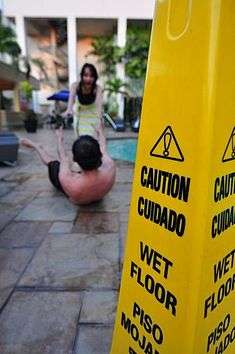Floor cleaning

Floor cleaning is a major occupation throughout the world. The main job of most cleaners is to clean floors.
Reasons for cleaning floors
The principal reasons for floor cleaning are:
- To prevent injuries due to tripping or slipping. Injuries due to slips and trips on level floors are a major cause of accidental injury or death. Bad practice in floor cleaning is itself a major cause of accidents.[1]
- To beautify the floor.
- To remove stains, dirt, litter and obstructions.
- To remove grit and sand which scratch and wear down the surface.
- To remove allergens, in particular dust.
- To prevent wear to the surface (e.g. by using a floor wax or protective sealant).
- To make the environment sanitary (e.g. in kitchens).
- To maintain an optimum traction (e.g. for dance floors).
Methods of floor cleaning
The treatment needed for different types of floors is very different.[2]
Slipping is a common safety hazard for cleaning methods that involve water or other liquids, especially if the floor is left wet.[3]
Sawdust is used on some floors to absorb any liquids that fall rather than trying to prevent them being spilt. The sawdust is swept up and replaced each day. This was common in the past in pubs and is still used in some butchers and fishmongers.[4]
It used to be common to use tea leaves to collect dirt from carpets and remove odours.[5] Nowadays it is still quite common to use diatomaceous earth, or in fact any cat litter type material, to remove infestations from floors.
There are also a wide variety of floor cleaning machines available today such as floor buffers, automatic floor scrubbers and sweepers, and carpet extractors that can deep clean almost any type of hard floor or carpeted flooring surface in much less time than it would take using a traditional cleaning method.
Wood flooring
Different types of wood flooring may require completely different care depending on whether they are waxed, oiled or have a polyurethane coating. It is important to determine the type of finish of a wood floor and always treat it in the proper manner, for instance it is difficult to clear wood floor wax from a floor coated with polyurethane. Simple cleaning instructions:[6]
- Clear the floor of any furniture that is easy to move.
- Sweep or vacuum all loose dirt and debris.
- Mop the floor, going along with the grain. For a polyurethane coated floor, dampen a mop with water and a few drops of dishwashing liquid. Be sure to ring out the mop thoroughly before using it on the floor. Run the mop back and forth, going with the grain of the wood in smooth strokes. Do not use water for lacquered or shellacked floors, as it can stain the wood and cause buckling.
- Buff the floor with a soft cloth to remove any soapy residue. Cloth diapers work well for buffing since they are very soft and absorbent.
Tile and stone flooring is common in kitchens, stairs, and bathrooms. Its cleaning process can be divided into three steps:
- Dirt or dust should first be removed with a vacuum cleaner or a broom.
- Have a floor cleaning solution or spray bottle for the appropriate floor. If you are cleaning stone floors (marble, granite, travertine, etc.), make sure the cleaning agent states that it is for stones. An acidic tile cleaning solution can be used on ceramic and porcelain floors
- After spraying the tile or stone floors in a small area, use a mop to clean and scrub floors.
Reducing the need for cleaning
A well-maintained entrance matting can dramatically reduce the need for cleaning. For public and office buildings about 80 to 90% of the dirt is tracked in from outside. Installing a total of 15 feet of matting consisting of both indoor and outdoor sections will remove about 80% of this.[7] Thus about two-thirds of the dirt can be removed at the entrance.
See also
- Carpet cleaning
- Cleaner
- Cleaning
- Floor
- Floor buffer
- Floor scrubbers
- Housecleaning
- Scrubber (brush)
- Spray-and-Vac Cleaning
- Terminal cleaning
References
- ↑ http://www.hse.gov.uk/pubns/web/slips02.pdf HSE information sheet: Slips and trips: The importance of floor cleaning
- ↑ http://home.howstuffworks.com/floor-cleaning-tips.htm howstffworks: Home cleaning: Floor-cleaning Tips
- ↑ http://www.hse.gov.uk/slips/kitchens/floorcleaning.pdf HSE: Stop slips in kitchens
- ↑ http://www.leg.state.nv.us/nrs/NRS-446.html#NRS446Sec841 NRS 446.841: Use of sawdust on floors in retail meat, poultry and fish markets
- ↑ http://www.burrows.com/carpetcleaning/index.html Historic Carpet Cleaning Methods in the Nineteenth and Twentieth Centuries
- ↑ "How to clean hardwood floors". Retrieved 25 August 2014.
- ↑ http://www.carpet-rug.org/pdf_word_docs/040504_CM_Guidelines.pdf The Carpet and rug Institute: Carpet Maintenance Guidelines
